parking brake CADILLAC ELDORADO 1993 10.G Owners Manual
[x] Cancel search | Manufacturer: CADILLAC, Model Year: 1993, Model line: ELDORADO, Model: CADILLAC ELDORADO 1993 10.GPages: 398, PDF Size: 20.66 MB
Page 76 of 398
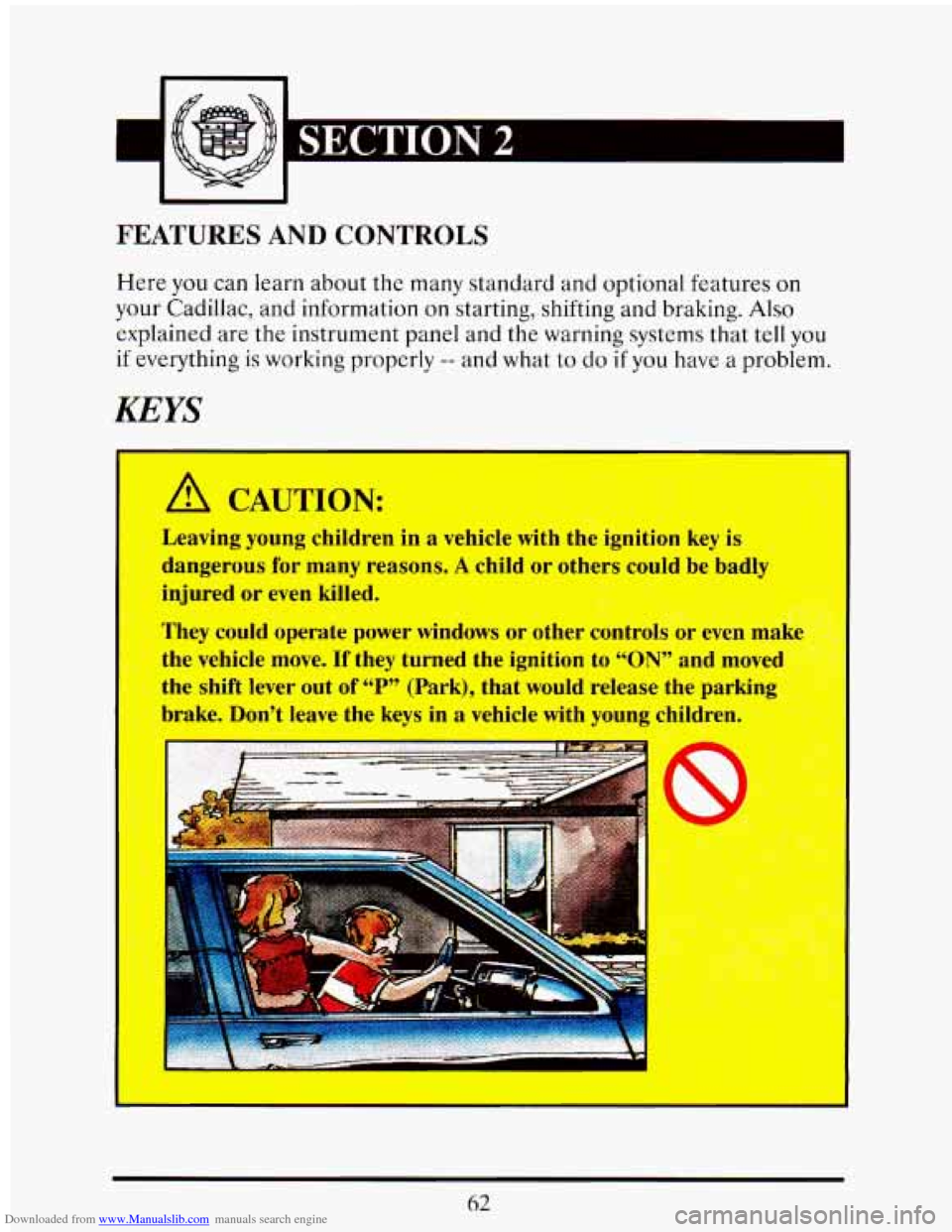
Downloaded from www.Manualslib.com manuals search engine -
FEATURES AND CONTROLS
Here you can learn about the many standard and optional features on
your Cadillac, and information on starting, shifting and braking. Also
explained are the instrument panel and the warning systems that tell you
if everything is working properly -- and what to do if you have a problem.
KEYS
I
-. . A CAUTION: I .- .,
:&!;Leaving young children in a vehicle with the ignition key is
‘$$dangerous for many reasons. A child or others could be badly +’A
uE ’
a. mjured or even killed. :a$. :.,gGbkG
They could operate power windows or other controls or even mrlki
the vehicle move.
If they turned the ignition to “ON” and move,
the shift lever out
of “P” (Park), that would release the parking
brake.
Don’t leave the keys in a vehicle with voung children. +-- !
g&:*?:wsac; ---’ :,: -3.5 -.
r, +n I. . A- ;
-
62
Page 95 of 398
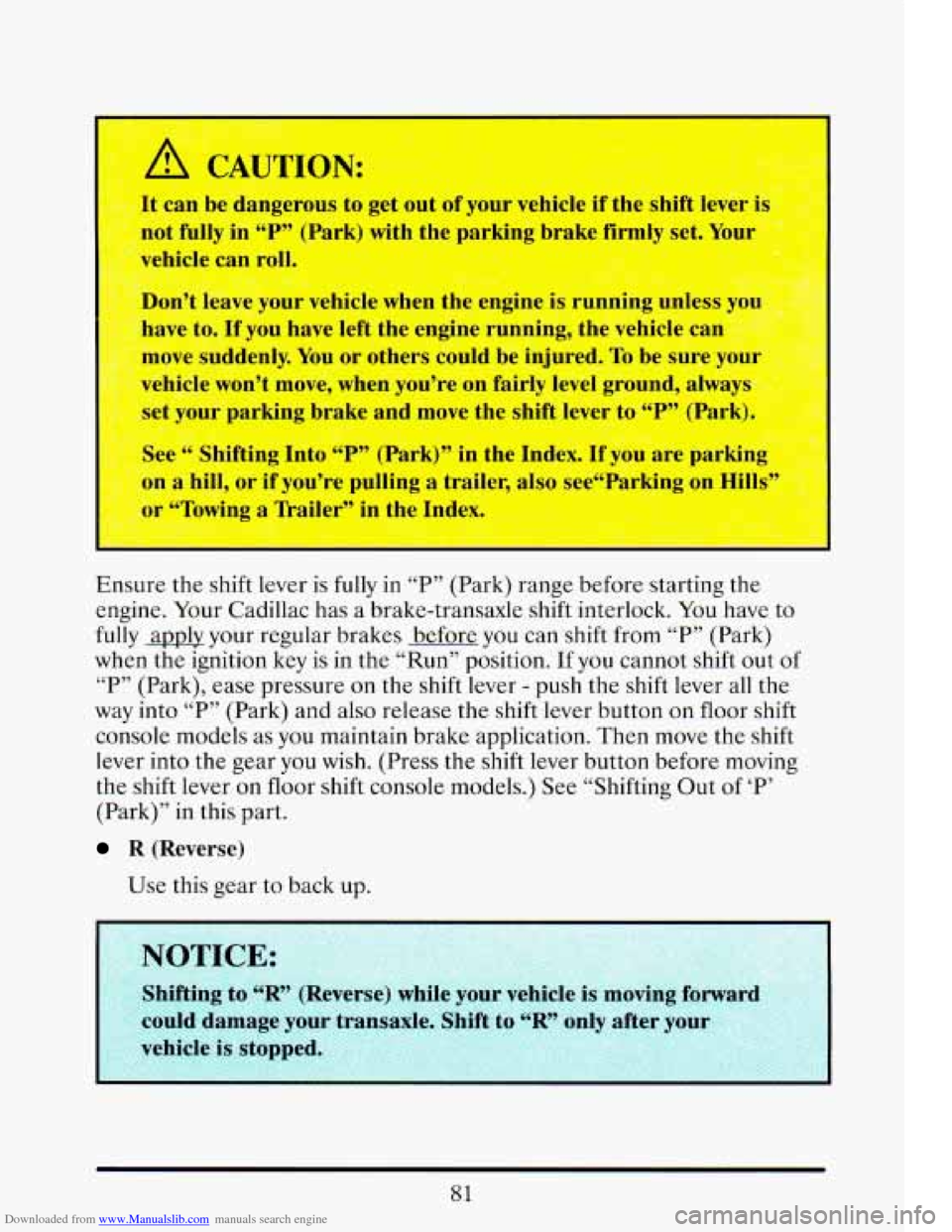
Downloaded from www.Manualslib.com manuals search engine vel le tan roll, $2-2.~
Don’t I enicle when the engine is runnmg unles
have
to. If you have left the engine running, the vehicle ca
move suddenly.
You or others could be injured. To be sure
vehicle won’t move, when you’re on
fairly level ground, alw
set your parking brake and move the shift lever to
“P” (Par
See “ snifting Into “P” (Park)” in the Index. 11 you are par
L a hill, or if you’re pulling a trailer, also see“Parking o
or “Towing a Trailer” in the Index.
-*- aq .: : - - . .. .h i-” .. .i T
..
Ensure the shift lever is fully in “P” (Park) range before starting the
engine. Your Cadillac has a brake-transaxle shift interlock. You have to
fully apply your regular brakes before
you can shift from “P” (Park)
when the ignition key is in the “Run” position.
If you cannot shift out of
“P” (Park), ease pressure on the shift lever - push the shift lever all the
way into “P” (Park) and also release the shift lever button on floor shift
console models as you maintain brake application. Then move the shift
lever into the gear you wish. (Press the shift lever button before moving
the shift lever
on floor shift console models.) See “Shifting Out of ‘P’
(Park)” in this part.
R (Reverse)
Use this gear to back up.
81
Page 99 of 398
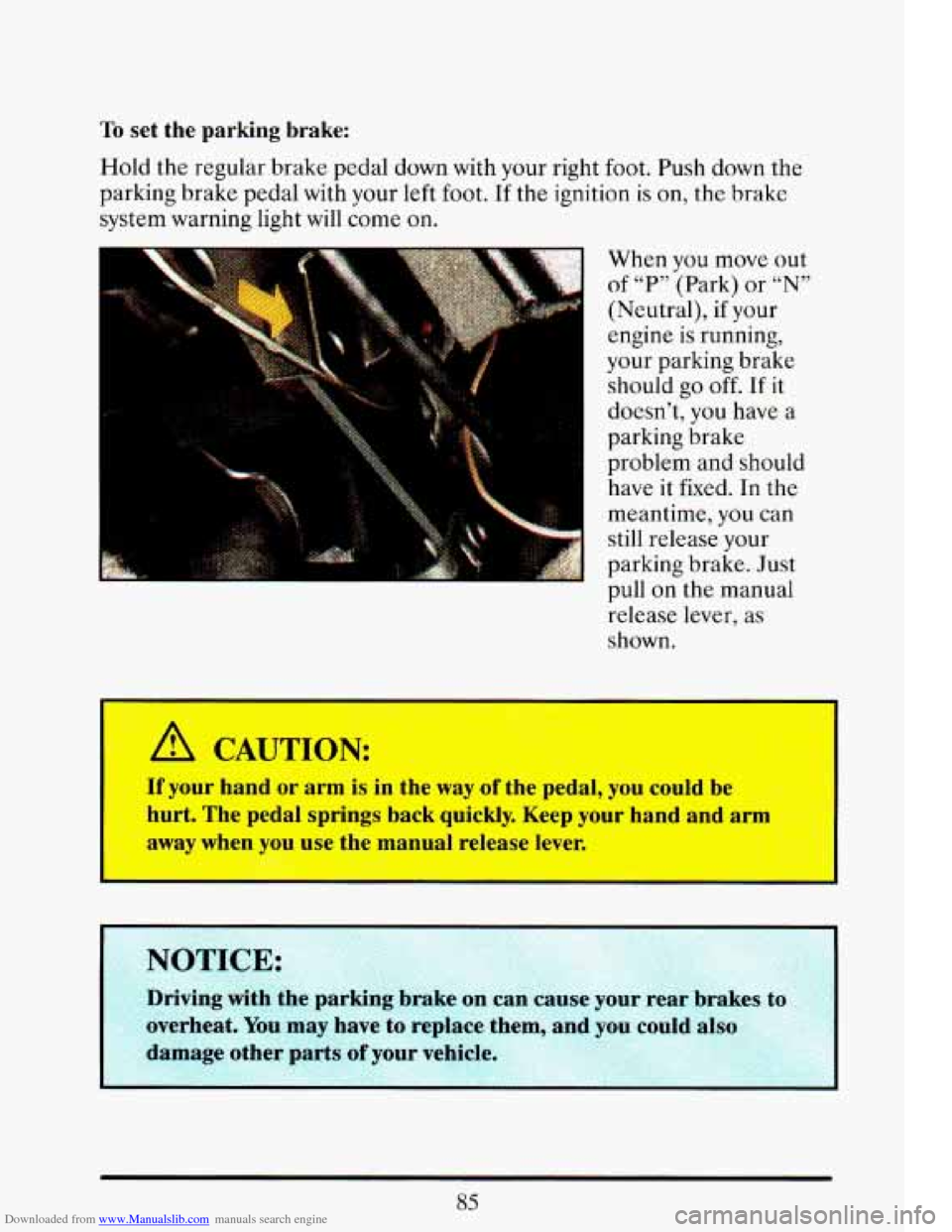
Downloaded from www.Manualslib.com manuals search engine To set the parking brake:
Hold the regular brake pedal down with your right foot. Push down the
parking brake pedal with your left foot. If the ignition
is on, the brake
system warnin? light
will come on.
I-
I
When you move out
of “P” (Park) or “N”
(Neutral), if your
engine
is running,
your parking brake should go off.
If it
doesn’t, you have a
parking brake
problem and should have it fixed.
In the
meantime,
you can
still release your
parking brake. Just
pull on the manual
release lever, as
shown.
I
3me-q 5::- &*ZL !My& se-4
A CAUTION: . -- .
If your hand or arm is in the way of thi’pedal, you could be -,::+ -+..:
hurt. The pedal springs back quickly. Keep your hand and arm !+. ,--,:“:
away when you use 1 ! manual release lever. :,F
.L- ..
-.7 7 .--.. , - ., .I .. - .>, _. .- : - .?f I - - .. - --. . ’-: .:. ..:= . ’. + .? .. .
NOTICE
Driving with the parking lake on can cause ~UL- rear bra,
overheat.
You mav have to replace them- and vou could also
,.*age ~ ~. .: . ~ i nther pal vnur vfihicle.
L .~-:’? . - I . - . i i .. ~
85
Page 100 of 398
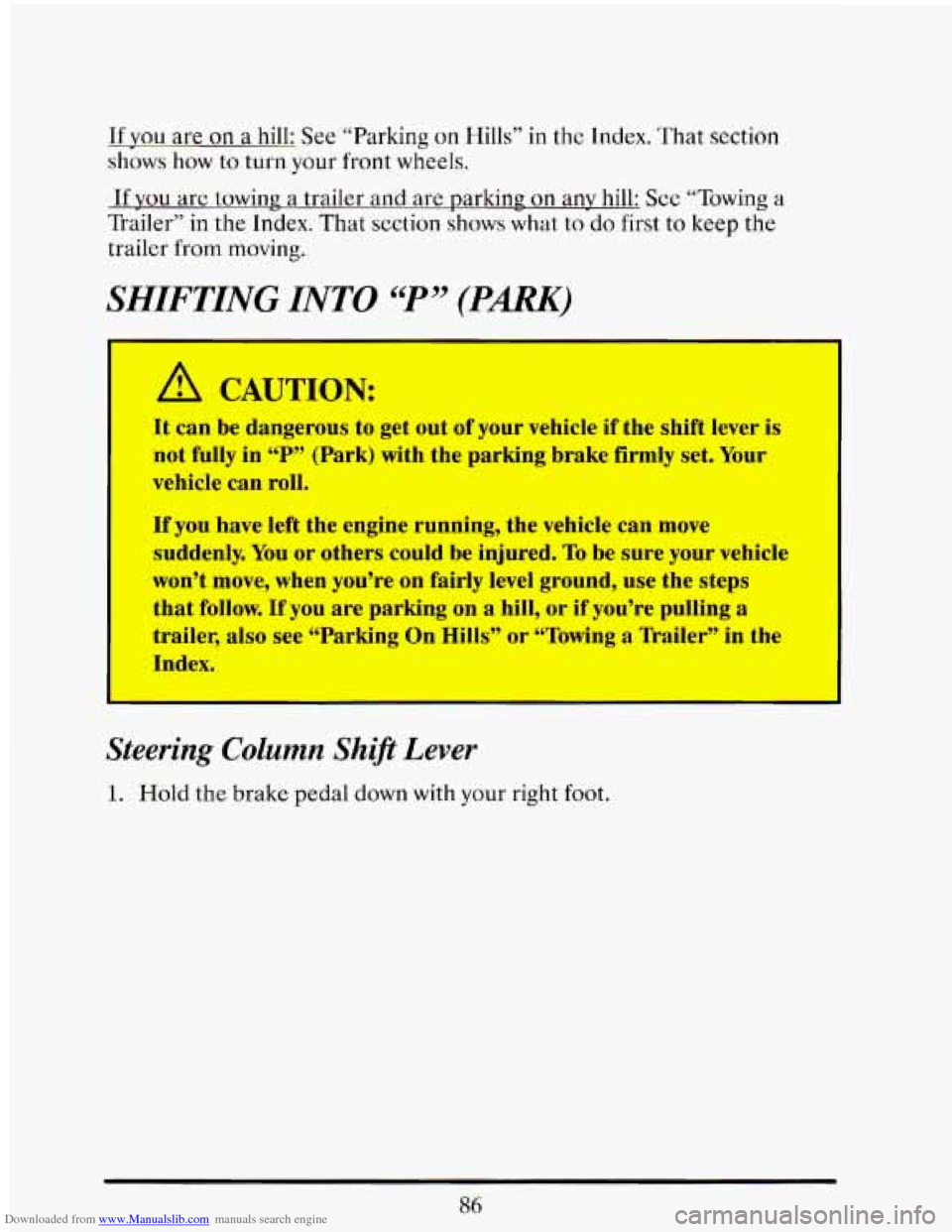
Downloaded from www.Manualslib.com manuals search engine If you are on a hill: See “Parking on Hills” in thc Index. That section
shows how to turn your front wheels.
If vou are towing a trailer and are parking; on anv hill: See “Towing a
Trailer” in the Index. That section shows what to do first to keep the
trailer from moving.
SHIFTING INTO ‘CPn (PARK)
I
A CAUTION:
It can be dangerous to get out of your vehicle if the shift lever is
not fully.in “P” (Park) with the parking brake firmly set. Your
vehicle can roll.
If you have left the engine running, the vehicle can move
suddenly.
You or others could be injured. To be sure your vehicle
won’t move, when you’re on fairly level ground, use the
steps
that follow. If you are parking on a hill, or if you’re pulling a
trailer, also see “Parking On Hills” or “Towing a Wailer” in the
Index.
-.
Steering Column Shifl Lever
1. Hold the brake pedal down with your right foot.
86
Page 101 of 398
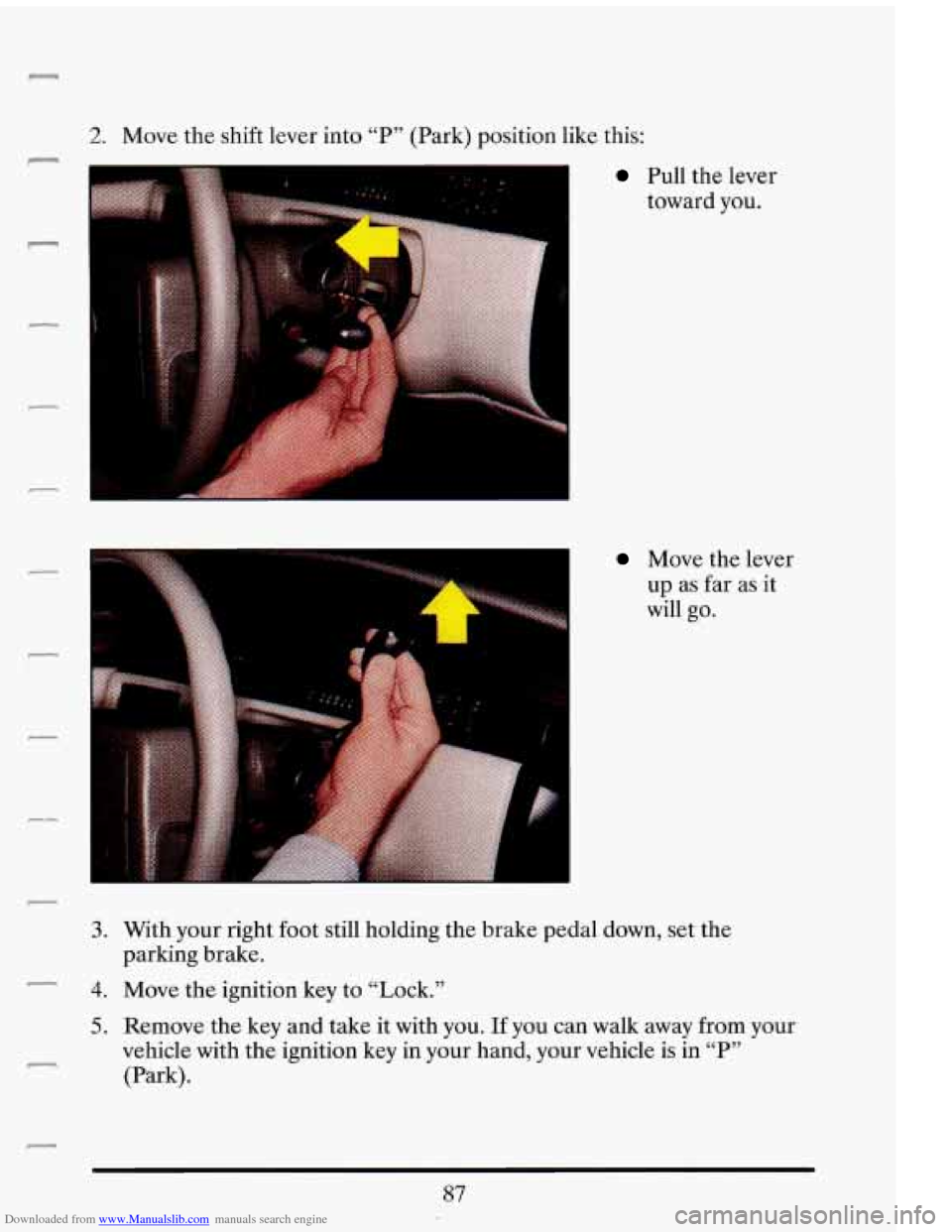
Downloaded from www.Manualslib.com manuals search engine r
2. Move the shift lever into “P” (Park) position like this:
Pull the lever
toward you.
Move the lever
up as far as it
will
go.
3. With your right foot still holding the brake pedal down, set the
4. Move the ignition key to “Lock.”
parking brake.
5. Remove the key and take it with you. If you can walk away from your
vehicle with the ignition key in your hand, your vehicle is in
“P”
(Park).
87
Page 102 of 398
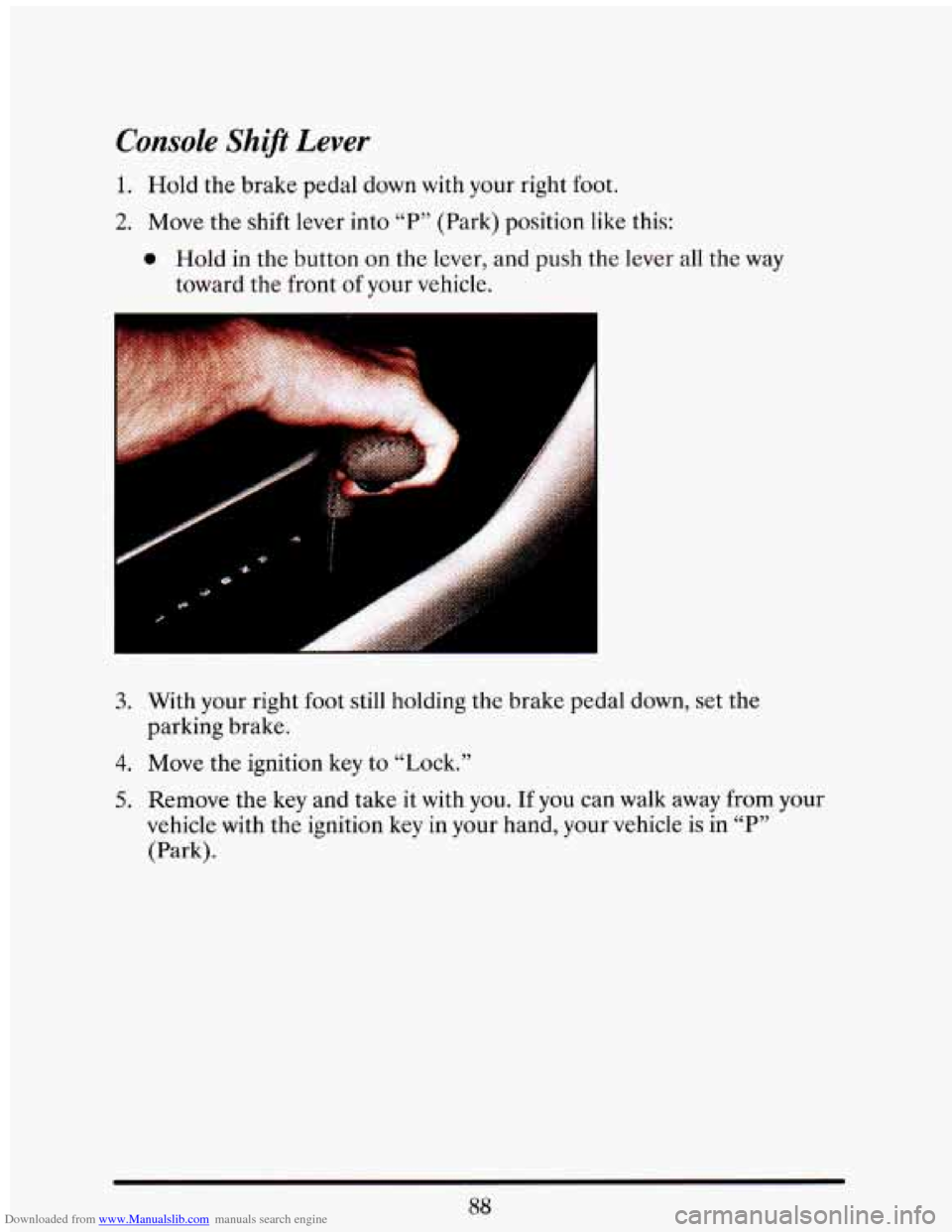
Downloaded from www.Manualslib.com manuals search engine Console Shift Lever
1. Hold the brake pedal down with your right foot.
2. Move the shift lever into “P” (Park) position like this:
0 Hold in the button on the lever, and push the lever all the way
toward the front
of your vehicle.
3. With your right foot still holding the brake pedal down, set the
parking brake.
4. Move the ignition key to “Lock.”
5. Remove the key and take it with you. If you can walk away from your
vehicle with the ignition key
in your hand, your vehicle is in “P”
(Park).
88
Page 103 of 398
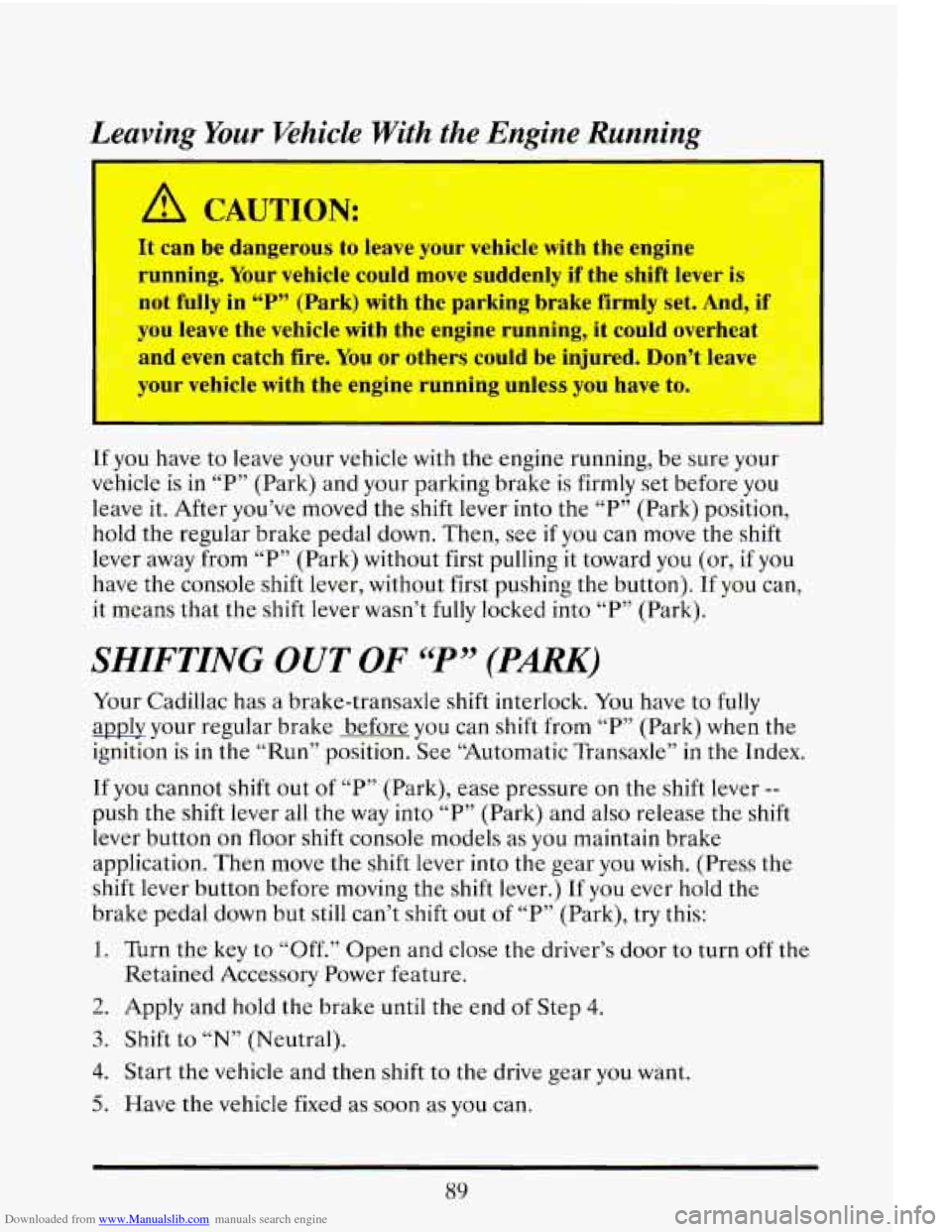
Downloaded from www.Manualslib.com manuals search engine Leaving Your Vehicle With the Engine Running
It can be dangerous to leave your vehicle with the engine ---.* . ’
running. Your vehicle could move suddenly if the shift lever is .- : :->=:I
not fully in “P” (Park) with the parking brake firmly set. And, i -
-”I leave the vehicle with the engine running, it could overheat
and even catch fire. You or others could be injured. Don’A
yo1 vehicle with the engine running unlc , you ha I
.-
. J .. .: . ?- -.. -. .. -
~ -- ~I
If you have to leave your vehicle with the engine running, be sure your
vehicle is
in “P7, (Park) and your parking brake is firmly set before you
leave
it. After you’ve moved the shift lever into the “P” (Park) position,
hold the regular brake pedal down. Then, see if you can move the shift
lever away from “P” (Park) without first pulling
it toward you (or, if you
have the console shift lever, without first pushing the button). If you can,
it means that the shift lever wasn’t
fully locked into “P7, (Park).
SHIFTING OUT OF “P” (PARK)
Your Cadillac has a brake-transaxle shift interlock. You have to fully
apply your regular brake before you can shift from
“P7’ (Park) when the
ignition is
in the “Run” position. See “Automatic Transaxle” in the Index.
If you cannot shift
out of “P” (Park), ease pressure on the shift lever --
push the shift lever all the way into “P” (Park) and also release the shift
lever button
on floor shift console models as you maintain brake
application. Then move
the shift lever into the gear you wish. (Press the
shift lever button before moving the shift lever.)
If you ever hold the
brake pedal down but still can’t shift out of “P” (Park), try this:
1. Turn the key to “Off.” Open and close the driver’s door to turn off the
2. Apply and hold the brake until the end of Step 4.
3. Shift to “N” (Neutral).
Retained
Accessory Power feature.
4. Start the vehicle and then shift to the drive gear you want.
5. Have the vehicle fixed as soon as you can.
Page 106 of 398
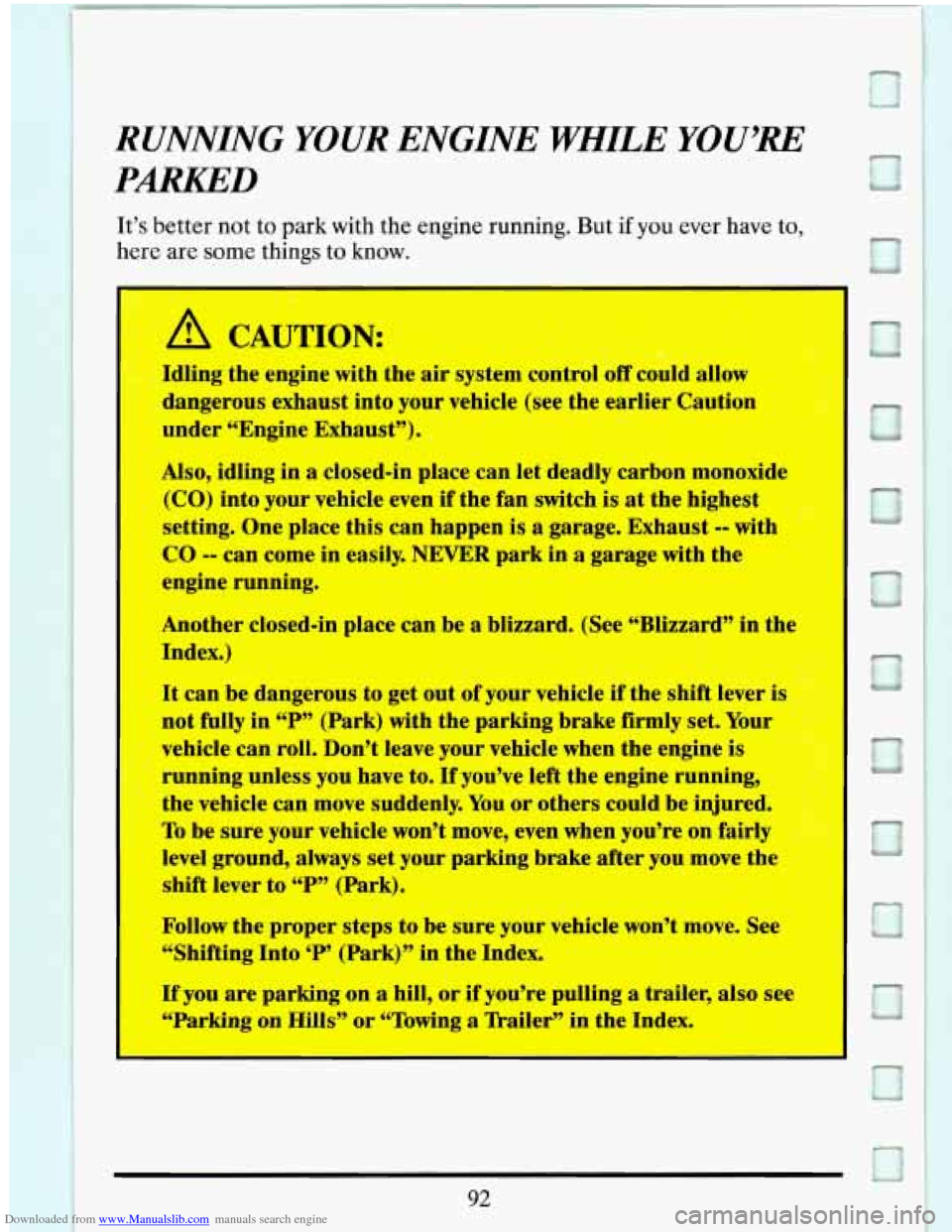
Downloaded from www.Manualslib.com manuals search engine RUNNING YOUR ENGINE ?KHILE YOU’RE
PARKED
It’s better not to park with the engine running. But if you ever have to,
here are some things to know.
ling the engine with the air system control off could allow
dangerous exhaust into your vehicle (see the earlier Caution
under “Engine Exhaust”).
~
Also, idling in a dosed-in place can let deadly carbon monoxide
(CO) intkpur vehicle even if the fan switch is at the highest
setting. One place this
can happen is a garage. Exhaust -- with
CO -- can come in easily. NEVER park in a garage with the
engine running.
Another closed-in place can be a blizzard. (See C6Blizzard” in the
Index.)
It
can be dangerous to get out of your vehicle if-the shin lever i
not fully in ccP” (Park) with the parking brake firmly set. Your
vehicle
can roll. Don’t leave your vehicle when the engine is
running unless
you have to. If you’ve left the engine running,
the vehicle can move suddenly. You or others could be iqjun ,,
To be sure your vehicle won’t move, even when you’re on fairly
level ground, always set your parking brake after
you move the
shift lever to “P’, (Park). ’
Follow the proper steps to be sure your vehicle won’t move. See
“Shifting Into ‘P’ (Park)” in the Index.
If you are parking on a hill, or if you’re pulling a trailer, also see
“Parking on Hills”
or 4T~~ a lhiler” in the Index.
I
92
Page 138 of 398
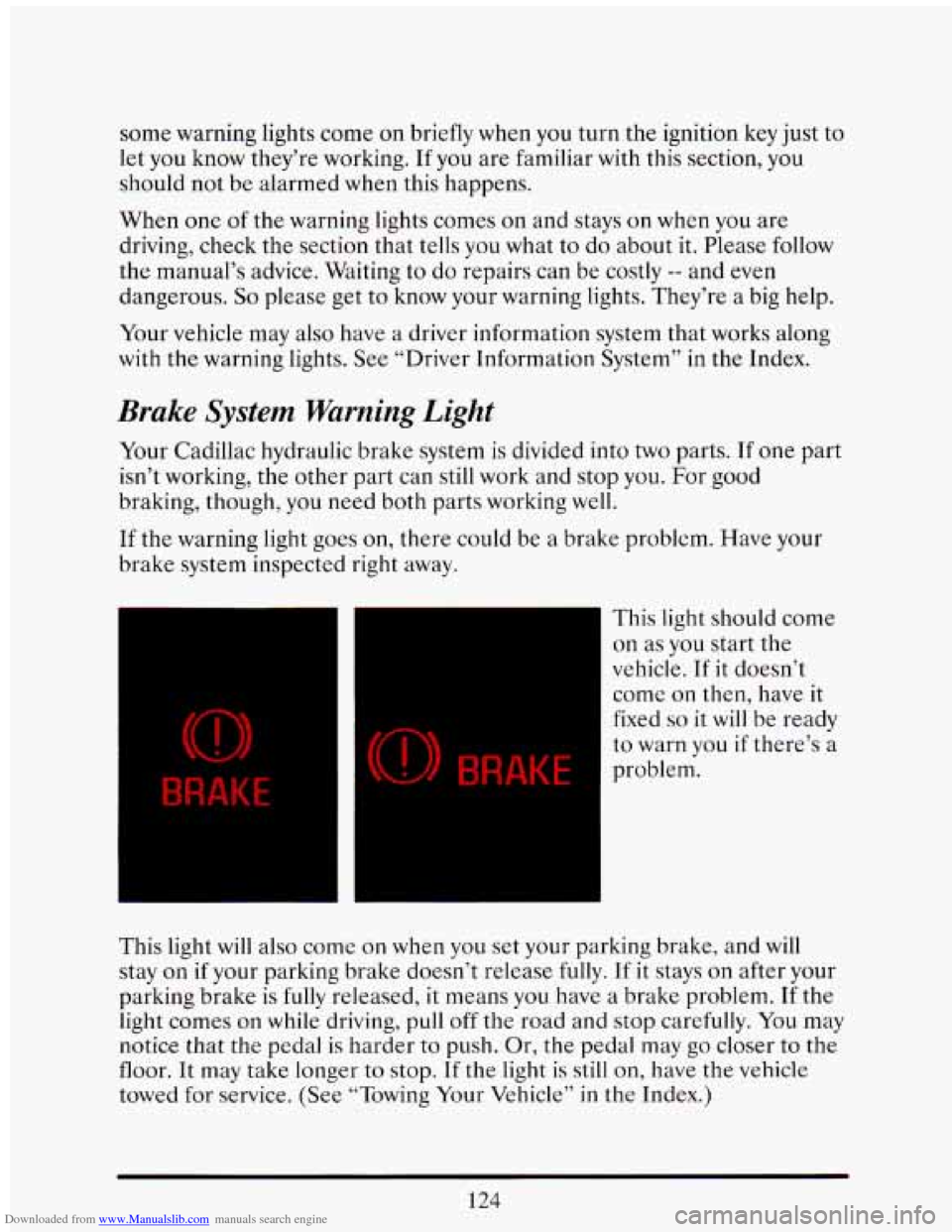
Downloaded from www.Manualslib.com manuals search engine some warning lights come on briefly when you turn the ignition key just to
let you know they’re working.
If you are familiar with this section, you
should not be alarmed when this happens.
When one
of the warning lights comes on and stays on when you are
driving, check the section that tells you what to do about it. Please follow
the manual’s advice. Waiting to do repairs can be costly
-- and even
dangerous.
So please get to know your warning lights. They’re a big help.
Your vehicle may
also have a driver information system that works along
with the warning lights. See “Driver Information System” in the Index.
Brake System Warning Light
Your Cadillac hydraulic brake system is divided into two parts. If one part
isn’t working, the other part can still work and stop you. For good
braking, though, you need both parts working
well.
If the warning light goes on, there could be a brake problem. Have your
brake system inspected right away.
BRAKE
(0) BRAKE
This light should come
on as you start the
vehicle. If it doesn’t
come
on then, have it
fixed
so it will be ready
to warn you if there’s a
problem.
This light will also come
on when you set your parking brake, and will
stay
on if your parking brake doesn’t release fully. If it stays on after your
parking brake
is fully released, it means you have a brake problem. If the
light comes
on while driving, pull off the road and stop carefully. You may
notice that the pedal is harder
to push. Or, the pedal may go closer to the
floor. It may take longer to stop.
If the light is still on, have the vehicle
towed for service. (See “Towing Your Vehicle” in
the Index.)
124
Page 186 of 398
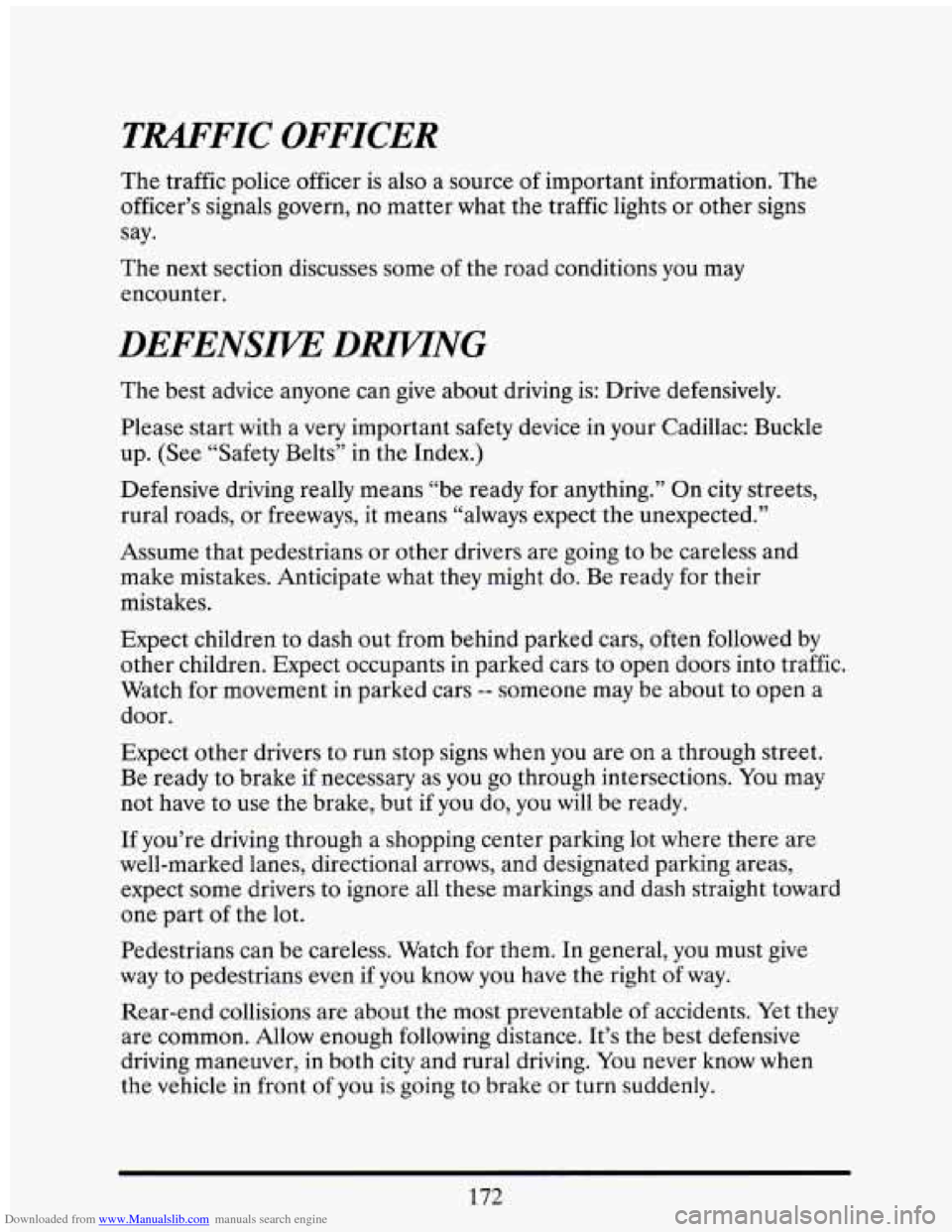
Downloaded from www.Manualslib.com manuals search engine TRAFFIC OFFICER
The traffic police officer is also a source of important information. The
officer’s signals govern, no matter what the traffic lights
or other signs
say.
The next section discusses some
of the road conditions you may
encounter.
DEFENSIVE DMNG
The best advice anyone can give about driving is: Drive defensively.
Please start with a
very important safety device in your Cadillac: Buckle
up. (See “Safety Belts” in the Index.)
Defensive driving really means “be ready for anything.” On city streets,
rural roads, or freeways, it means “always expect the unexpected.”
Assume that pedestrians or other drivers are going to be careless and
make mistakes. Anticipate what they might do. Be ready for their
mistakes.
Expect children to dash out from behind parked cars, often followed by
other children. Expect occupants in parked cars to open doors into traffic.
Watch for movement in parked cars
-- someone may be about to open a
door.
Expect other drivers to run stop signs when you are
on a through street.
Be ready to brake if necessary as
you go through intersections. You may
not have to use the brake, but if
you do, you will be ready.
If you’re driving through a shopping center parking lot where there are
well-marked lanes, directional arrows, and designated parking are\
as,
expect some drivers to ignore all these markings and dash straight toward
one part
of the lot.
Pedestrians can be careless. Watch for them. In general, you must give
way
to pedestrians even if you know you have the right of way.
Rear-end collisions are about the most preventable of accidents. Yet they
are common. Allow enough following distance. It’s the best defensive
driving maneuver,
in both city and rural driving. You never know wh.en
the vehicle in front
of you is going to brake or turn suddenly.
172